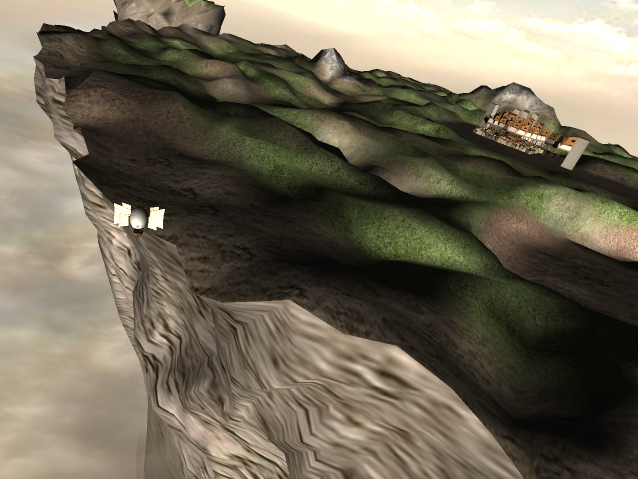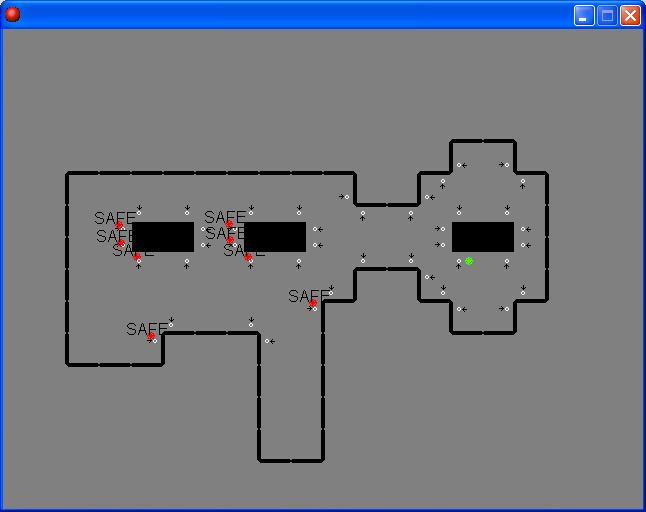So LotAII is no longer a ship game… at least, not a water ship game. I've changed the focus and the graphical look and feel, while keeping the gameplay idea the same…
LotAII is now Cloud Ocean.So it's looking good. Really good. Commercial good. I honestly think this project has the best graphics ever made with GM. I've managed to add in the following:* Cloudscape* Bloom* 2-4x Antialiasing* LOD and a gigantic world* "Semisepia" color filterAll running at >30fps (normally ~120) at the same time.Plus, X3d doesn't bat an eyelash at high-polygon models - 12000 extra polygons only caused a 3-4fps dip. I'm thinking fully-explorable cityscapes integrated with my brawl engine…Images, then my brawl engine description:

 Above: I moved up to scare away all the enemies in the left side of the room. After a bit of rabbit chasing (they may just walk around the table to get away from you) they were all corralled in the other room. Note that certain enemies are still running; if a hiding spot is too crowded, they won't tend to favor it. In this case their response is more one of "terminal situational indecision."
Above: I moved up to scare away all the enemies in the left side of the room. After a bit of rabbit chasing (they may just walk around the table to get away from you) they were all corralled in the other room. Note that certain enemies are still running; if a hiding spot is too crowded, they won't tend to favor it. In this case their response is more one of "terminal situational indecision." Above: And again, I scared them back across the room. Some enemies will cluster around the sides of a table facing you; it's far enough away/close enough to them that they feel safer there (but probably aren't). My stated goal for these fights is that they should realistically involve up to 10 characters in a single region or area. I think that this system does adequately complete my goal; hence, I am quite pleased with it.Basic rules of engagement:One or two swordfighters may engage someone else in a swordfight. People with guns should stand a ways away and fire at their enemies (moving back if needed; they can be cornered if you can avoid the stream of bullets)If you have a gun and someone else does as well, they may either begin firing at you or (if more prudent) run for a coverspot with a leaning opportunity, then lean out and shoot at you.If you have a gun and they don't, they run for cover, as seen above.If they don't have any cover (say, a square room), they may simply charge you, or cower in fear or back away. The goal is to make your enemies seem human.Combat details:You have an extremely limited number of hit points (5 at the moment; attacks may take up to 4 at once) and 8 balance points (needed to perform various attacks). Balance points recharge with time, but slower when blocking. Almost all attacks and blocking take balance points to perform; the blockbreaker will damage an enemy's balance and bring him out of block. Blocking and using initiative is crucial; oftentimes a major enemy attack will leave him open for a few seconds.
Above: And again, I scared them back across the room. Some enemies will cluster around the sides of a table facing you; it's far enough away/close enough to them that they feel safer there (but probably aren't). My stated goal for these fights is that they should realistically involve up to 10 characters in a single region or area. I think that this system does adequately complete my goal; hence, I am quite pleased with it.Basic rules of engagement:One or two swordfighters may engage someone else in a swordfight. People with guns should stand a ways away and fire at their enemies (moving back if needed; they can be cornered if you can avoid the stream of bullets)If you have a gun and someone else does as well, they may either begin firing at you or (if more prudent) run for a coverspot with a leaning opportunity, then lean out and shoot at you.If you have a gun and they don't, they run for cover, as seen above.If they don't have any cover (say, a square room), they may simply charge you, or cower in fear or back away. The goal is to make your enemies seem human.Combat details:You have an extremely limited number of hit points (5 at the moment; attacks may take up to 4 at once) and 8 balance points (needed to perform various attacks). Balance points recharge with time, but slower when blocking. Almost all attacks and blocking take balance points to perform; the blockbreaker will damage an enemy's balance and bring him out of block. Blocking and using initiative is crucial; oftentimes a major enemy attack will leave him open for a few seconds.
You could download the DLL and try it out…
Don't be so modest… :P
Looking good!Holy-ducking-moly!
I LUVZ IT AND I WILLZ DOWNLIS IT NOWZ PLEASE!
It looks great, I can't wait to try it.@Geo, OpenGL has problems simply because directX is now totally hardware-driven and working to composite the desktop area continually, openGL isn't native, so it doesn't run as fast.
Looks nice but I would not call it commercial except for the clouds.